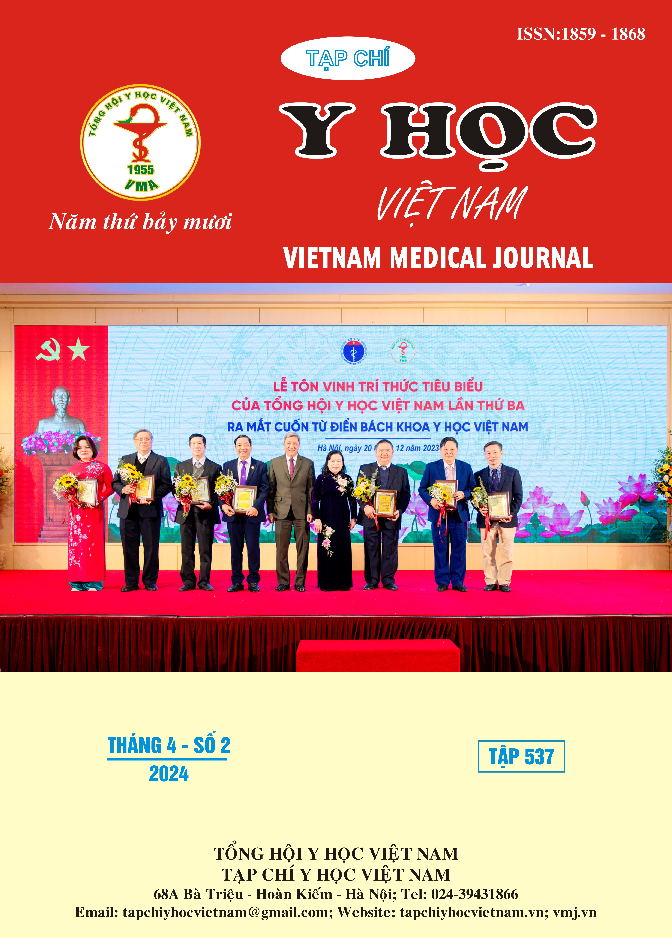ASSESSMENT OF THE RISK OF EMBOLISM IN ELDERLY PATIENTS UNDERGOING SURGERY AT HUU NGHI HOSPITAL
Main Article Content
Abstract
Objective: Evaluate the risk of thromboembolism in elderly patients undergoing surgery at Huu Nghi Hospital. Subjects and methods: Prospective descriptive study, 100 patients ≥ 60 years old, operated at Huu Nghi hospital. Results: Mean age was 76.25 ± 7.53 years. The proportion of male patients is 81.0%. Chronic diseases before surgery: Hypertension 44.9%, Diabetes 33.4%, lipid metabolism disorders 31.0%, Cancer 31.5%. Average surgery time was 119.03 ± 55.57 minutes. Average anesthesia time was 163.6 ± 45.93 minutes. Digestive surgery accounts for 35.3%. Stomach cancer surgery accounts for 42.25% of cancer diseases. Padua score ≥4 is 38.8%. Risk factors for embolism: advanced cancer in 26.2%, history of thrombosis in 14.9%, heart failure or respiratory failure in 41.9%, and acute infection in 15.8%. Caprini score is 6.03 ± 1.27 (3-15 points), caprini score 5-6 accounts for 49.2%. The overall rate of diagnosis of thromboembolism was 2.4%, in the high-risk group it was 6.2%, and disseminated intravascular coagulation in the high-risk group was 3.45%. Conclusion: The average caprini score in the study was 6.03 ± 1.27 points, caprini scores 5-6 accounting for 49.2%. The rate of Padua score ≥ 4 is 38.8%. The rate of risk factors for thromboembolism: cancer is 26.2%, history of venous thromboembolism is 2.9%, age > 70 is 79.1%, heart failure and respiratory failure is 41.9%, acute infection is 15.8%. The overall rate of diagnosis of thromboembolism was 2.4% and 6.4% in the high-risk group.
Article Details
Keywords
embolism, the elderly, surgery.
References
2. al, A.D.e., (2014) Venous Thromboembolism in Cancer Patients. Hospital Practice. 42(5).
3. Ngô Minh Diệp, (2018) Luận văn thạc sĩ Y học: "So sánh mối liên quan của chỉ số đau ANI và SPI với thang điểm PRST trong gây mê toàn thân để phẫu thuật mở ổ bụng ở người cao tuổi", in Bộ môn Gây mê hồi sức. Đại học Y Hà Nội.
4. Paul S. Myles, (2016) Stopping vs. Continuing Aspirin before Coronary Artery Surgery. The New England Journal of Medicine. 374(8): p. 728-37.
5. Võ Văn Tâm, (2014) Khảo sát tần suất huyết khối tĩnh mạch sâu ở chi dưới trên bệnh nhân phẫu thuật thay khớp gối hoặc khớp háng nghiên cứu quan sát dịch tễ học. Y Học TP. Hồ Chí Minh. 18(2).
6. Nguyễn Văn Trí, (2016) Khuyến cáo về chẩn đoán, điều trị và dự phòng thuyên tắc huyết khối tĩnh mạch của Hội Tim mạch học quốc gia Việt Nam. Nhà xuất bản Y Học.
7. Huỳnh Văn Ân, (2013) Đặc điểm lâm sàng và hình thái của huyết khối tĩnh mạch sâu chi dưới ở bệnh nhân suy tim mạn tính. Y Học TP. Hồ Chí Minh. 17(6): p. 116 ‐ 120.
8. Nguyễn Thế Tùng, (2013) Khảo sát tình trạng đông máu trước phẫu thuật trên bệnh nhân tại bệnh viện trường đại học Y Khoa Thái Nguyên năm 2012. Y Học TP. Hồ Chí Minh 17(5): p. 160 ‐ 164.
9. Bùi Thị Mỹ Hạnh, (2019) Ứng dụng thang điểm caprini hiệu chỉnh trong đánh giá nguy cơ huyết khối tĩnh mạch trên người bệnh phẫu thuật mạch máu. Tạp chí Nghiên cứu Y Học. 122(6): p. 65-71.


